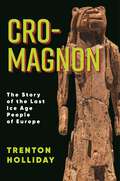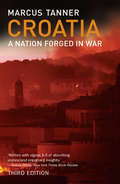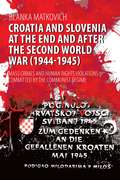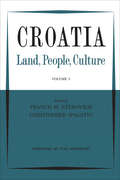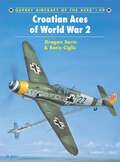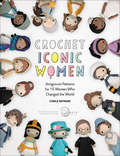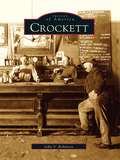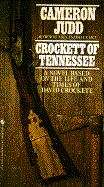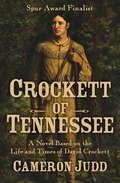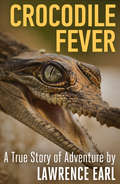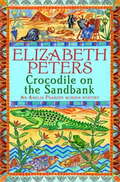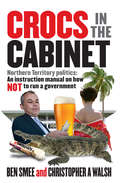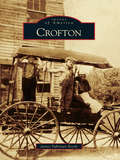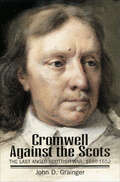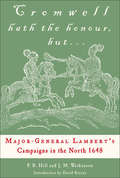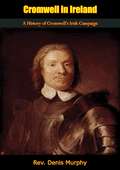- Table View
- List View
Crito
by PlatoIt depicts a conversation between Socrates and his wealthy friend Crito regarding justice (δικαιοσύνη), injustice (ἀδικία), and the appropriate response to injustice. Socrates thinks that injustice may not be answered with injustice, and refuses Crito's offer to finance his escape from prison. This dialogue contains an ancient statement of the social contract theory of government.
Cro-Magnon: The Story of the Last Ice Age People of Europe
by Trenton W. HollidayDuring the Last Ice Age, Europe was a cold, dry place teeming with mammoths, woolly rhinoceroses, reindeer, bison, cave bears, cave hyenas, and cave lions. It was also the home of people physically indistinguishable from humans today, commonly known as the Cro-Magnons. Our knowledge of them comes from either their skeletons or the tools, art, and debris they left behind.This book tells the story of these dynamic and resilient people in light of recent scientific advances. Trenton Holliday—a paleoanthropologist who has studied the Cro-Magnons for decades—explores questions such as: Where and when did anatomically modern humans first emerge? When did they reach Europe, and via what routes? How extensive or frequent were their interactions with Neandertals? What did Cro-Magnons look like? What did they eat, and how did they acquire their food? What can we learn about their lives from studying their skeletons? How did they deal with the glacial cold? What does their art tell us about them?Holliday offers new insights into these ancient people from anthropological, archaeological, genetic, and geological perspectives. He also considers how the Cro-Magnons responded to Earth’s postglacial warming almost 12,000 years ago, showing that how they dealt with climate change holds valuable lessons for us as we negotiate life on a rapidly warming planet.
Croatia
by Marcus TannerFrom the ashes of former Yugoslavia an independent Croatian state has arisen, the fulfillment, in the words of President Franjo Tudjman, of the Croats' "thousand-year-old dream of independence. " Yet few countries in Europe have been born amid such bitter controversy and bloodshed: the savage war between pro-independence forces and the Yugoslav army left about one-third of the country in ruins and resulted in the flight of a quarter of a million of the country's Serbian minority. In this book an eyewitness to the breakup of Yugoslavia provides the first full account of the rise, fall, and rebirth of Croatia from its medieval origins to today's tentative peace. Marcus Tanner describes the creation of the first Croatian state; its absorption into feudal Hungary in the Middle Ages; the catastrophic experience of the Ottoman invasion; the absorption of the diminished country into Habsburg Austria; the evolution of modern Croatian nationalism after the French Revolution; and the circumstances that propelled Croatia into the arms of Nazi Germany and the brutal, home-grown "Ustashe" movement in the Second World War. Finally, drawing on first-hand knowledge of many of the leading figures in the conflict, Tanner explains the failure of Tito's Communists to solve Yugoslavia's tortured national problem by creating a federal state, and the violent implosion after his death. Croatia's unique position on the crossroads of Europe-between Eastern and Western Christendom, the Mediterranean, and the Balkans and between the old Habsburg and Ottoman empires-has been both a curse and a blessing, inviting the attention of larger and more powerful neighbors. The turbulence and drama of Croatia's past are vigorously portrayed in this powerful history.
Croatia
by Marcus TannerFrom the ashes of former Yugoslavia an independent Croatian state has arisen, the fulfillment, in the words of President Franjo Tudjman, of the Croats' "thousand-year-old dream of independence. " Yet few countries in Europe have been born amid such bitter controversy and bloodshed: the savage war between pro-independence forces and the Yugoslav army left about one-third of the country in ruins and resulted in the flight of a quarter of a million of the country's Serbian minority. In this book an eyewitness to the breakup of Yugoslavia provides the first full account of the rise, fall, and rebirth of Croatia from its medieval origins to today's tentative peace. Marcus Tanner describes the creation of the first Croatian state; its absorption into feudal Hungary in the Middle Ages; the catastrophic experience of the Ottoman invasion; the absorption of the diminished country into Habsburg Austria; the evolution of modern Croatian nationalism after the French Revolution; and the circumstances that propelled Croatia into the arms of Nazi Germany and the brutal, home-grown "Ustashe" movement in the Second World War. Finally, drawing on first-hand knowledge of many of the leading figures in the conflict, Tanner explains the failure of Tito's Communists to solve Yugoslavia's tortured national problem by creating a federal state, and the violent implosion after his death. Croatia's unique position on the crossroads of Europe--between Eastern and Western Christendom, the Mediterranean, and the Balkans and between the old Habsburg and Ottoman empires--has been both a curse and a blessing, inviting the attention of larger and more powerful neighbors. The turbulence and drama of Croatia's past are vigorously portrayed in this powerful history.
Croatia and Slovenia at the End and After the Second World War (1944-1945): Mass Crimes and Human Rights Violations Committed by the Communist Regime
by Blanka MatkovichThis book focuses on the events that took place in late 1944 and 1945 in Croatia and Slovenia when the intensity of violence was strongest. At that time, the Communist Party of Yugoslavia (KPJ), assisted by the People’s Liberation Army of Yugoslavia, the Yugoslav Army, the Department for the Protection of the People (OZNA) and the Corps of People’s Defence of Yugoslavia (KNOJ) conducted organized terror not only by intimidation, persecution, torture and imprisonment, but also by the execution of a large number of citizens perceived by the KPJ as disloyal, passive, ideological enemies or class enemies. However, investigating war and post-war crimes committed by communist regime was not possible until 1990, after the democratic changes in Yugoslavia. This book is based on documents kept in the archives of Croatia, Slovenia, the UK, and Serbia. Many of them, especially those in Croatia, recently became available to the public, which makes them extremely valuable source of data to the academics and students in this field and which shed new light on these historical events.°The Communist Party in the former Yugoslavia was an organization which used all available means to seize and keep power, including terror and mass murder, especially between autumn 1944 and summer 1945 when mass killings occurred across the country. However, in the Soviet sphere of influence, investigating war and post-war crimes committed by communist regimes was not possible until 1990. This project not only covers new ground in the research into communist war crimes at the end of and after the Second World War, but also contributes to coming to terms with the past in the successor states of Yugoslavia by studying one of the most controversial episodes in the contemporary history of the Balkans.°Since the October Revolution, when for the first time in history a Marxist party seized state power, communist regimes have influenced the lives of more than a billion people, caused millions of deaths and violated the human rights of countless people. However, in the Soviet sphere of influence and in Yugoslavia, investigating war and post-war crimes committed by communist regimes was not possible until 1990, after the democratic changes in Eastern Europe. Resolution 1481/2006 of the Council of Europe Parliamentary Assembly strongly condemned human rights violations committed by totalitarian communist regimes and the 2008 Prague Declaration on European Conscience and Communism stated that these crimes were comparable with Nazi crimes but, very few people have been tried for committing such crimes. Nevertheless, 25 years later, in former Yugoslav republics this topic is still a matter of political and scientific debates.
Croatia: Land, People, Culture Volume I
by Francis Eterovich Christopher SpalatinThis book represents a survey of the cultural and economic life of the Croatian people, who have long been noted for their significant contributions to the arts and the humanities. It contains a wealth of factual information on various aspects of one of the most interesting regions in Europe. The authors of the articles which make up this work are all specialists in their respective fields. They have compiled a scholarly review of many of the notable works by Croatian historians, political scientists, artists, and persons in other fields. There is also general information on various aspects of geography and demography, and statistics on population, ecology, religion, nationality and other important areas of Croatian life are included. Other important features are ten maps showing the administrative divisions of Yugoslavia and adjacent countries, and 32 pages of illustrations depicting folk arts, handicrafts, music, painting, sculpture and architecture. This reference work will be invaluable to libraries, and will be a useful source of information for historians, writers on Central European affairs, students of art and ethnic developments, and the layman interested in the Croatian people and their cultural history.
Croatia: Land, People, Culture Volume II
by Francis Eterovich Christopher SpalatinThis volume continues the story of the cultural and political history of the Croatian people who have long been noted for their significant contributions to the arts and the humanities. It examines the Croatian language, literature to 1835, the maritime history of the eastern Adriatic, Croatian political history from 1526 to 1918, the development of book printing, the ethnic and religious history of Bosnia and Hercegovina, the cultural achievement of Bosnian and Hercegovinian Muslims, and Croatian immigrants in North America. Each of the nine chapters in the book is written by a specialist and is accompanied by an extensive bibliography. Other special features of this volume are eleven historical maps of the region, a geographical map, sixteen pages of illustrations, and a glossary of geographical names. This reference work will be invaluable to libraries, and will be a useful source of information for historians, writers on Central European affairs, students of art and ethnic developments, and the layman interested in the Croatian people and their cultural history.
Croatian Aces of World War 2
by John Weal Boris CiglicInitially flying Italian-supplied Fiat G.50s, the Croat forces suffered heavy losses during 1942 whilst flying alongside JG 52 in the southern sector of the Russian front. Despite this, a significant number of kills fell to future aces such as Cvitan Galic and Mato Dubovak during this time, and when the units re-equipped with Bf 109G-10s in 1943, battle-seasoned Croat pilots started to rack up impressive scores. This book reveals how, by 1944, Croat air groups were defending Yugoslavia from British and American air raids, and in the final months of the war a handful of surviving pilots fought on until final defeat in May 1945.
Crochet Iconic Women: Amigurumi Patterns for 15 Women Who Changed the World
by Carla MitraniCrochet patterns depicting world-changing women from Marie Curie to Malala, using the Japanese art of amigurumi.Whether it's Greta, RBG, or Billie Holiday, this collection of crochet patterns celebrates fifteen women who have made an impact on the global stage in fields like politics, sports, and science. Learn more about each of the characters featured in this collection and make unique gifts to inspire and delight all generations.Marie Curie • Cleopatra • Queen Elizabeth II • Malala Yousafzai • Rosa Parks • Billie Holiday • Ruth Bader Ginsburg • Serena Williams • Greta Thunberg • Jane Goodall • Amelia Earhart • Jane Austen • Florence Nightingale • Audrey Hepburn • Emmeline Pankhurst
Crockett
by John V. RobinsonThe small town of Crockett rests on the shore of the Carquinez Strait, a narrow shipping waterway running from San Francisco Bay into the Sacramento Delta region. Crockett's early history was heavily influenced by the shipping industry, and the shoreline was filled with warehouses and wharves. Twin cantilever bridges across the Carquinez Strait at Crockett distinguish the town's skyline from other ports in the area. A third span was recently added across the strait and named in honor of Crockett native Alfred Zampa. Much of Crockett's identity has been associated with the C&H sugar refinery, and for more than 50 years, Crockett was a devoted company town.
Crockett of Tennessee: A Novel Based on the Life and Times of David Crockett
by Cameron JuddThis historical fiction novel traces the life of David (Davy) Crockett from his early poverty-stricken life in the Tennessee Territory to his death defending the Alamo. In between are a strained relationship with his father, a cattle drive, an aborted attempt to become a sailor, two marriages, war with the Creeks, his tenure as Congressman, and various scrapes brought about by his friendship with Persius Tarr, and other events.
Crockett of Tennessee: A Novel Based on the Life and Times of David Crockett
by Cameron JuddFinalist for the Spur Award: The thrilling adventures of an American icon come alive in this vivid and authentic retelling of his remarkable story From humble beginnings in rural Tennessee to his heroic death defending the Alamo, frontiersman, adventurer, and politician David &“Davy&” Crockett embodies the spirit and ideals of the national character. Even during his lifetime, tales of the sharpshooting, skilled woodsman were—to his delight—told, retold, and elaborated on. As a US congressman, the former Creek War militiaman steadfastly opposed President Andrew Jackson&’s Indian Removal Act. As a soldier, he made the ultimate sacrifice fighting for an independent Texas. Nearly two centuries after his untimely demise, he remains a legendary figure in American lore. In this fictional account of Crockett&’s life, author Cameron Judd offers a nuanced portrait of the man behind the myth. He depicts Crockett&’s triumphs as a hunter, cattle drover, warrior, and legislator in riveting detail and poignantly illustrates his subject&’s hardscrabble youth and complicated relationship with his father. Meticulously researched and rich in vibrant action, Crockett of Tennessee captures the charisma, ambition, and bravery of the man known as the &“King of the Wild Frontier.&”
Crockett: The Real-Life Adventures of the Frontier Legend
by Buddy Levy&“A great myth-busting story, written in a taut narrative style that is guaranteed to keep the reader up all hours turning the pages.&” —Martin Dugard, coauthor of the #1 New York Times bestseller Killing Lincoln (with Bill O&’Reilly)Crack open the most in-depth, exciting portrait of Davy Crockett ever written, from acclaimed bestselling adventure-history author Buddy Levy. Inside is more than just the tale of the coonskin-cap-wearing frontiersman who heroically sacrificed himself at the Battle of the Alamo, but of the real man behind the King of the Wild Frontier myth. From a humble childhood and meager education, the legendary adventurer David Crockett led a distinguished life, winning three elections as a congressman and earning a presidential nomination. Buddy Levy reveals the fascinating truth of Crockett, beyond the newspaper spins and folkloric celebrity status, as a figure that both embraced and clashed with the identity of the American Old West. He was charismatic, down-to-earth, pioneering, independent to a fault, and his adventures have been warped beyond recognition by Hollywood hype. But in this beautifully written narrative, Davy Crockett emerges as never before: a rugged individual, a true American original, and an enduring symbol of the Western frontier.
Crocodile Fever: A True Story of Adventure
by Lawrence EarlCrocodile Fever, first published in 1954, is a fascinating look at the life and adventures of Bryan Herbert Dempster. Dempster, born in South Africa, was perhaps the first white man to successfully hunt crocodiles, not for sport but to obtain their skins for his livelihood. The book details the risks and special techniques he developed by long trial-and-error to hunt these river creatures, as well as his personal struggles with his failing health, his estranged family, and impassive government officials. Much of the hunting took place in the Kariba Gorge of the Zambezi River, now completely inundated by the Kariba Dam and part of the world's largest man-made lake. Included are 16 pages of photographs. Author Lawrence Earl was an internationally known journalist, novelist, and photographer.
Crocodile on the Sandbank: Miss Marple crossed with Indiana Jones! (Amelia Peabody #1)
by Elizabeth PetersAmelia Peabody is Elizabeth Peters' most brilliant and best-loved creation, a thoroughly Victorian feminist who takes the stuffy world of archaeology by storm with her shocking men's pants and no-nonsense attitude!In this first adventure, our headstrong heroine decides to use her substantial inheritance to see the world. On her travels, she rescues a gentlewoman in distress - Evelyn Barton-Forbes - and the two become friends. The two companions continue to Egypt where they face mysteries, mummies and the redoubtable Radcliffe Emerson, an outspoken archaeologist, who doesn't need women to help him solve mysteries -- at least that's what he thinks!'Think Miss Marple with early feminist gloss crossed with Indiana Jones... Dastardly deeds, whirlwind romances, curious mummies and all the fun and intrigue of Egyptian excavations, with a heroine who wields a sturdy parasol rather than a magnum. Accomplished entertainment.' Guardian
Crocs in The Cabinet: Northern Territory politics an instruction manual on how NOT to run a government
by Ben Smee Christopher A. WalshGoings-on in Northern Territory politics from 2012-2016 may read like satire, but it is all true. These are stories you couldn't make up. This book is an instruction manual on how NOT to run a government.In the Top End, politics is not a numbers game, it is a blood sport.In comparison to Rudd, Gillard, Abbott and Turnbull, the goings-on in the Northern Territory parliament are like watching a troop of clowns throwing knives into each other's backs.CROCS IN THE CABINET is partly a serious political book, partly a riotous look at the characters, the scandals and the incompetence of Northern Territory politics. It will make you laugh, cry, wince and shake your head as you read of:- a minister with a hostess club bill- a masturbating minister and the lewd videos he sent someone other than his wife- why a minister shouted 'we are in love' on the floor of the parliament- how the Chief Minister stared down a coup- how an MP forced the evacuation of a hotel- why an MP went fishing instead of dealing with leadership matters- exactly how bonkers the NT parliament really is.Written by two of the NT NEWS's best journalists, Walkley Award-winning Ben Smee and award-winning Christopher A. Walsh, this is FEAR AND LOATHING ON THE CAMPAIGN TRAIL meets FAWLTY TOWERS.
Crofton (Images of America)
by Janice BoothEstablished in 1964 as a planned community, Crofton's almost 2,000 acres have been colonized and cultivated since the mid-17th century. Its roots can be traced to America's first planned community--Williamsburg, Virginia. Williamsburg's elegance and charm inspired developer W. Hamilton Crawford's idyllic design for Crofton: a grand boulevard, curving residential streets, arching trees, a country club, and easy access to nearby Washington, D.C., and Baltimore. This collection of photographs from the mid-19th to the mid-20th century reflects the life and times of the maturing village of Crofton. Fields of tobacco and corn, towering woodlands, cherry tree saplings along Crofton Parkway, the dedication of Crofton Park, summer Little League camp--Images of America: Crofton is a compendium of dreams fulfilled. Independence Day parades; fairs; bicycle races; pumpkin-design competitions; softball, soccer, and basketball teams; and summer concerts on the Green are all here. While historians record the facts, artists and cameras capture the small moments as well as the grand events. Those moments, large and small, are what readers will find between these covers.
Cromartie vs. the God Shiva: A Novel (Virago Modern Classics Ser. #177)
by Rumer GoddenLove, intrigue, and death ensue when a statue of a Hindu god is stolen from an Indian hotel in this masterwork from a New York Times–bestselling author. Sydney Cromartie is aghast when London officials inform him that his precious statuette of the Hindu god Shiva is in fact an artifact stolen from India, its mother country. But, despite the insistence of the Indian government, the irate Canadian art collector will not give it up without a legal fight. English barrister Michael Dean is thrilled to be assigned to a case that will allow him to return to his native India. Arriving at Patna Hall—the quaint seaside hotel on the Coromandel coast where the theft allegedly took place—he quickly launches into his investigation, casting suspicion on everyone, including the inn&’s vivacious Anglo-Indian proprietress, Auntie Sanni. But there are complexities Dean never anticipated—and one very serious distraction: his emerging feelings for a mysterious archaeologist. Still, he must remain resolute, even if the facts he&’s at risk of uncovering could lead to disappointment, disillusionment, even tragedy. In her final novel, award-winning author Rumer Godden returns to southern India and the charming beachfront resort that was the site of her popular Coromandel Sea Change. Based on a real late twentieth-century incident—when a Hindu god became, in essence, the plaintiff in a sensational legal case—Cromartie vs. the God Shiva is an unforgettable tale from a writer of &“depth and sensitivity&” (Los Angeles Times) and &“a novelist of many gifts&” (TheDaily Telegraph). This ebook features an illustrated biography of the author including rare images from the Rumer Godden Literary Estate.
Cromwell Against the Scots: Last Anglo-Scottish War, 1650-52
by John D. GraingerAfter an introduction establishing Cromwell's war against the Scots from July 1650 to May 1652, this book discusses Charles' landing and Fairfax's resignation as commander-in-chief of the English Republican Army, both events occurred on the same day. It then addresses the causes of the war, Charles II's landing in Northern Scotland from the Continent. The story continues chronologically, from Cromwell's invasion of Scotland, through the Battle of Dunbar, and the slow establishment of the king's power over the Scottish government. The end came with the fall of the last of the Scottish castles, Dunnottar, to English conquest. The Scots enjoyed a distinct military recovery after the Dunbar defeat, but their aims and those of the king were always at cross purposes: the king was intent on the invasion of England, the Scots on resistance to English conquest. Finally, Cromwell's manoeuvres in the summer of 1651, and the English victory at Inverkeithing, allowed the king to invade England. This ended in another Scots defeat at Worcester. The removal of the Scots Army to England meanwhile allowed the English under Monck to complete their conquest of Scotland. Throughout, the political dimension, particularly in Scotland, is kept in view. At the end, the author comments on the relevance of these events to the present Scottish situation.
Cromwell Against the Scots: The Last Anglo-Scottish War, 1650–1652
by John D. GraingerAlthough also known as the Third English Civil War, the author makes it clear that this was the last war between the Scots and English as separate states. He narrates in detail the the events following the exiled King Charles II’s landing in Scotland and his alliance with the Scots Covenanters, erstwhile allies of the English Parliamentarians. Cromwell’s preemptive invasion of Scotland led to the Battle of Dunbar, a crushing defeat for the Scots under David Leslie, though this only unified the Scottish cause and led to the levying of the Army of the Kingdom under Charles II himself. Charles II led a desperate counter-invasion over the border, hoping to raise a royalist rebellion and forcing Cromwell to follow him, though he left Monck to complete the pacification of Scotland. Cromwell caught up with Charles II at Worcester, where the Scots/Royalist army was decisively defeated and destroyed, thousands of the prisoners being sold into slavery in the West Indies and the American colonies. This revised and updated edition contains an expanded chapter on the aftermath of the war and the fate of the POWs, drawing on major new archaeological evidence, as well as an expanded Conclusion.
Cromwell Cruiser Tank 1942-50
by Peter Sarson David FletcherFor most of World War II, British tank development remained faithful to the design philosophy inaugurated during World War I. Experiences in North Africa highlighted flaws in this basic design, however, and the General Staff identified the need for a new heavy cruiser that could combine speed and manoeuvrability with increased armour and armament. The Cromwell Cruiser tank was designed as a result and soon proved itself one of the fastest and most successful tanks deployed by the Allies during World War II. This book details the design and development of the Cromwell and its many variants, from its introduction at D-Day, through its many successes in the final year of World War II and beyond.
Cromwell Hath the Honour, but . . .: Major-General Lambert's Campaigns in the North 1648
by P. R. Hill J. M. Watkinson David BreezeCromwell hath the honor, but Lamberts discreet, humble, ingenious, sweet and civil deportment gains him more hugs and ingenious respect.Much has been written about the first Civil War and the triumphs of Oliver Cromwell. Less is known, however, of the skirmishes of the second Civil War, especially in the north, or of the role and military prowess of the excellent young Parliamentarian commander Major-General John Lambert. Not only was Lambert a brilliant general who demonstrated exceptional tactical skills but he was also a brave and humane leader who was well liked by his men and merciful to his captured enemies, refusing to undertake the harsh actions indulged in by Cromwell.This carefully researched and highly readable new account reexamines contemporary sources to shed new light on Lamberts decisive northern campaign of 16481649. Remarkably detailed and supported by maps and photographs, this is an important source for the general reader and military historian alike.
Cromwell and Centaur Tanks: British Army and Royal Marines, North-west Europe, 1944–1945 (Tank Craft Ser. #16)
by Dennis Oliver&“An excellent resource for one just starting out trying to model one of these beasts . . . great background information.&” —AMPS Designed with the hard lessons of the North African campaign in mind, including the adoption of a dual-purpose gun capable of firing high-explosive and anti-tank rounds, the Cromwell was one of the most successful of the British cruiser tanks produced during the Second World War. The lack of heavy armor was made up for by the tank&’s high speed, provided by a Rolls-Royce Meteor engine. The Centaur was externally almost identical to the Cromwell, the major difference being the installation of the less powerful Liberty engine. While the Centaur equipped the Royal Marines during the Normandy battles, the Cromwell served until the end of the war and formed the basis for the Comet. In his fifth book in the TankCraft series, author and illustrator Dennis Oliver uses official wartime photographs and comprehensively researched, exquisitely presented color profiles to tell the story of the penultimate British cruiser tank. As with all the titles in the TankCraft series, the large full-color section features available model kits and accessories as well as aftermarket products. In addition to the color profiles, there is a gallery of expertly constructed and painted models. A separate section explains technical details and modifications made during production and in the field, giving the modeler all the information required to create an authentic replica of one of the tanks that served from the Normandy beaches to the final battles in Germany.
Cromwell and His Women
by Julian WhiteheadOliver Cromwell, a pivotal and often contentious character, has long been the focus of many historical works that chart his meteoric rise from being a middle-aged farmer from East Anglia with no previous military experience, who rose to command the army and become one of England’s greatest generals. Like him or loath him, Oliver Cromwell is a giant of English history. With a deft hand and strong narrative, Whitehead guides us through the remarkable life and career of Oliver Cromwell from a unique perspective. He explores not only the effect the women in Cromwell’s life had on him, but how his career in turn dramatically altered their lives. We learn of his close relationship with his mother, who lived with him throughout her long life, and of his deep attachment to his wife Elizabeth, who he married at 22 and without whom it is doubtful he would have achieved all he did.
Cromwell in Ireland: A History of Cromwell’s Irish Campaign
by Rev Denis MurphyFirst published in Ireland only in 1883, this book is a fascinating account of the Irish campaign of 1649-1650 led by Oliver Cromwell (1599-1658), the English military and political leader and later Lord Protector of the Commonwealth of England, Scotland, and Ireland, as told by the Irish Rev. Denis Murphy of the Society of Jesus.“The object of this work is to give an account in full detail, as far as is possible, of Cromwell’s Irish campaign, which began in August, 1649, and ended in May, 1650. It is a portion of history but little known. It lies for the most part in a few books, some of them difficult of access by reason of their scarcity, others written in a language not intelligible to the greater number of readers. Traditions, indeed, there are still surviving of the doings of Cromwell and his followers, many of them having, no doubt, a foundation of truth; but many, too, exaggerations at best, and not a few wholly unfounded and false. In truth, there is hardly a ruined church throughout the length and breadth of the land, the destruction of which is not attributed to Cromwell, or a crumbling castle of which it is not said that“‘Oliver CromwellHe did it pommel,And made a breachIn its battlement.’“Evil deeds are attributed to him as done where he never set foot, and names are given to places that would seem at first sight to record his presence there, but in reality have had their origin in the wish of his followers to perpetuate their leader’s fame, or in the hatred of those among whom they dwelt, who would hand down the record of his cruelties by an appellation which in their minds summed up all manner of evil.”

